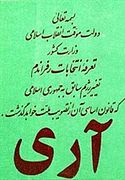| | ||||||||||||||||
| ||||||||||||||||
In the Name of God Interim Government of the Islamic Revolution Ministry of Interior Referendum Election Ballot Change of previous regime into Islamic Republic the constitution of which to be approved by the nation. [2] | ||||||||||||||||
The two-parts ballot of referendum, with the green paper indicating "Yes" and red paper indicating "No" [2] | ||||||||||||||||
| Results | ||||||||||||||||
|---|---|---|---|---|---|---|---|---|---|---|---|---|---|---|---|---|
| ||||||||||||||||
| ||
|---|---|---|
Personal 1st Supreme Leader of Iran Legacy | ||
A referendum on creating an Islamic Republic was held in Iran on 30 and 31 March 1979. Political parties such as the National Democratic Front and the Organization of Iranian People's Fedai Guerrillas boycotted the referendum.
Contents
The People's Mojahedin Organization of Iran, the Tudeh Party of Iran, the Freedom Movement of Iran, the National Front, and the Islamic People's Republican Party, also "objected to the imposition of Khomeini's choice". [4] According to official results, it was approved by 98.2% of eligible citizens. [3] [5] However, votes were color-coded and voting booths were lacking, explaining the unusually high approval rate. [6]
In order to include the Iranian youth who participated in the revolution, the voting age was lowered from 18 to 16. [3]
Following this, the 1906 constitution was declared invalid and a new constitution for an Islamic state was created and ratified by another referendum in December 1979.



